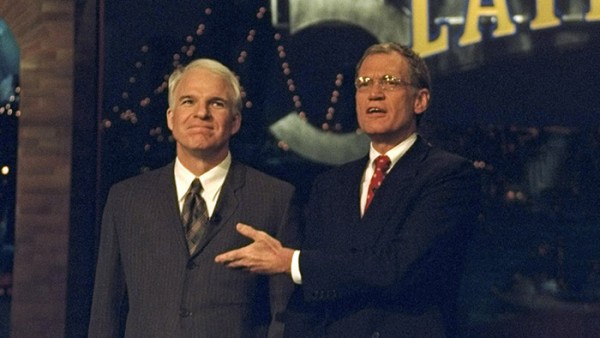by Michael Sheridan of CRS Coffeelands Blog
Tonight is the last broadcast of the Late Show with David Letterman. In homage to his 33 years on the air, I offer this coffee-focused mash-up of the venerable “Top 10 List” and the comparatively lesser-known sketch “Is this anything?”
The first needs no introduction; the second featured oddball performances by guests, then banter between Dave and Paul Schaffer to determine whether what they had just seen was “nothing” or indeed was “something.” The list below represents The Top 10 issues that have emerged through our work in coffee and conversations with leaders in the coffee sector as definite “somethings.”
So here they are, from the home office in Quito, Ecuador, the Top 10 Somethings in Coffee:
10. Performance-Based Measurement
The specialty coffee category was born nearly 30 years ago. And for almost as long, specialty coffee companies have been working, sometimes alone but more often in partnership with others, to make coffee trade more inclusive. A slew of initiatives, from certifications to projects to business model innovations, have been celebrated for their contributions to human development in the coffeelands. Yet despite a quarter-century of innovation and investment in the name of sustainability, smallholder coffee growers are still struggling mightily, and we still don’t have clarity about what works.
9. Research for Resilience
In a context of climate change and increasing threats to coffee production, breeding to develop new cultivars that combine high yields, disease resistance and cup quality has assumed added urgency. Research to improve decision-making is also vitally important. Fortunately, breeding programs are humming right now at research institutes and private labs around the world and decision-support research is being conducted by World Coffee Research: the International Multi-Location Varietal Trial, the Variety Intelligence Project, the sensory lexicon, etc. More funding for both, and for social research, would be welcome contributions.
8. Smallholder Economics
There has been lots of hand-wringing lately about the prospect that the children of smallholder coffee growers will not follow their parents into coffee. Who could blame them? With hunger and poverty still commonplace on many smallholder coffee farms, threats to production increasing, farms getting smaller through inheritance and subdivision, access to extension and finance still limited and market volatility on the rise, there seem to be lots of better ways to make a living.
7. Farmer Organization
This issue is so important that the International Coffee Organization devoted the Coffee Finance Forum during its 50th Annual Meeting to it. It’s not just that actors all along the supply chain from growers to roasters are missing market opportunities as a result of the lack of more effective farmer organization on the ground, it’s that the farmer organizations that have been nominally successful over the past generation are in many cases struggling to keep up in a marketplace that is increasingly specialized and complex.
6. Workers, Women and Youth
Our research into labor conditions on coffee farms has revealed that the disturbing conditions described in this outstanding investigative series in the Los Angeles Times are not just present on farms growing tomatoes for the U.S. market, but also on coffee farms. Our conversations with leaders in specialty coffee on this issue have confirmed emphatically our sense that despite the relative lack of attention devoted to this issue in coffee’s sustainbility is indeed “something.” And workers represent only one massive group on the margins of the coffee trade. Women are systematically underrepresented in all aspects of the coffee trade and the youth in the coffeelands who represent the future of the trade struggling to find a place for themselves.
5. Forests, Water and Soils
Coffee is a quiet environmental hero. It is something of a “Lorax crop” – it doesn’t speak for the trees, exactly, but in many countries it does create the most reliable incentives for maintaining the forests in which coffee grows. My colleague Paul Hicks told an SCAA Symposium audience last month that, “There is no better agricultural system than shade-grown coffee for regulating the water cycle.” And coffee-based agroforestry systems aren’t too shabby, either, in the soils department.
4. Climate Change
Does this really need an explanation?
3. Policy
Policy in coffee-growing countries helps to determine who participates in the coffee sector and how. The barriers to entry for smallholders. The degree to which farmworkers are protected. Whether wastewater is treated at wet mills before it is discharged to rivers and streams. In the marketplace, policies to ensure food safety are requiring investments in upgrades in supply chain transparency, among other things. Getting public policy “right” can go a long way to making the coffee trade work better for people and for the planet.
2. Corporate Engagement to Create Shared Value
Policy is important, but the incentives that the private sector creates are often more powerful than any regulatory framework in getting farmers to act. Indeed, private-sector initiatives catalyze most of the world’s economic growth and environmental degradation. That hasn’t gone unnoticed. Soon the UN will finalized its Sustainable Development Goals, the next-generation goalposts for global development. The are expected to lean harder on the private sector than the Millennium Development Goals or UN Global Compact did. If we are going to get traction on all the somethings above, we don’t just need innovation for social inclusion and a lighter environmental footprint within supply chains, we need new models of cooperation focused on these issues across supply chains.
And the number one “something” in coffee is:
1. Coffee Sector Governance
OK, so it’s NOT the sexiest item on the list. But none of the stakeholders in the global coffee industry can effectively address these mighty somethings alone, or even through the kind of collaboration across supply chains I mention in #2 above. Real progress will require the kind of platform for permanent cross-sector engagement the industry doesn’t have right now: a place where industry can relate on all these key issues in real-time with banks, governments, coffee institutes, donors, growers associations, research centers, non-profits and other key stakeholders.
Michael Sheridan
Michael Sheridan is the Chief Executive Officer of the Coffee Quality Institute, a nonprofit organization with a mission to improve coffee quality and the lives of those who produce it. Sheridan has been leveraging market forces to make coffee work for smallholder farmers and farm workers since 2004. Most recently he directed progressive green coffee sourcing activities and direct-trade partnerships at Intelligentsia Coffee. Prior to that he worked to deliver initiatives in the coffee sector in Central and South America on behalf of Catholic Relief Services.












Comment